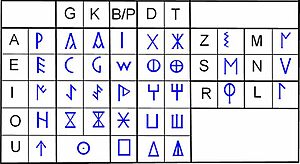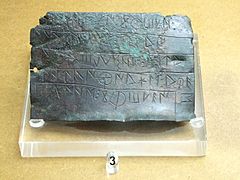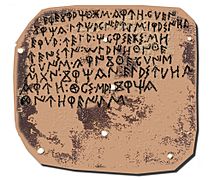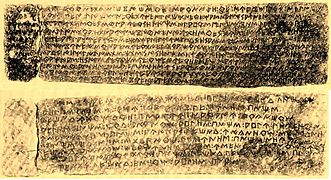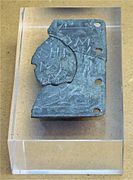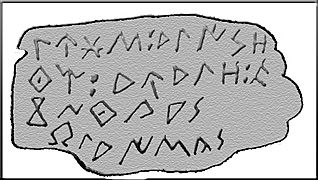Celtiberian script facts for kids
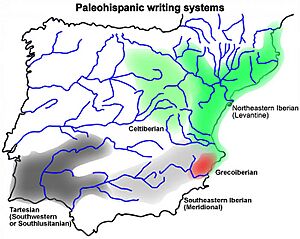
The Celtiberian script was an ancient way of writing. It was the main writing system for the Celtiberian language. This language was spoken by the Celtiberians, an ancient people in what is now Spain. The Celtiberian language is now extinct. Sometimes, the Celtiberians also used the Latin alphabet to write. This special script came from another old writing system. It was adapted from the northeastern Iberian script.
Contents
How the Celtiberian Script Began
Most ancient scripts from the Iberian Peninsula are called Paleohispanic scripts. They had a unique way of working. For some sounds, like 'p', 't', or 'k', they used symbols for whole syllables. For example, one symbol might mean 'pa', and another 'pi'. But for other sounds, like vowels (a, e, i, o, u) and some consonants, they used single letters.
This means they were not true alphabets, like the one we use today. They were also not true syllabaries, where every symbol is a syllable. Instead, they were a mix, often called semi-syllabaries. Experts are still discussing how these scripts started. Some think they came only from the Phoenician alphabet. Others believe the Greek alphabet also played a part.
Understanding the Celtiberian Signs
The Celtiberian script had 26 different signs or symbols. Its original model, the northeastern Iberian script, had 28 signs. The Celtiberians left out two signs. They removed one of the two 'r' sounds and one of the three 'n' sounds.
The 26 signs included:
- 5 vowels (like 'a', 'e', 'i', 'o', 'u')
- 15 syllabic signs (like 'ka', 'ke', 'ki', 'ko', 'ku', 'ta', 'te', etc.)
- 6 consonants (like 'l', 's', 'z', 'r', and two 'n' sounds)
One interesting thing is how they wrote 's' sounds. A sign that was 's' in Iberian became 'z' in Celtiberian. This 'z' sound might have been like the 'th' in "the". Another Iberian 's' sound was written as 's' in Celtiberian.
There were two main versions of the Celtiberian script:
- Eastern Celtiberian: This version left out the Iberian 'm' sound.
- Western Celtiberian: This version left out a different 'm' sound, called 'ḿ'.
This difference suggests the script might have developed in two places. The western version of Celtiberian also had a special feature. It could show the difference between sounds like 'g' and 'k', or 'd' and 't'. They did this by adding a small line to the symbol for the 'k' or 't' sound. This is known as the 'dual system'. Most other Paleohispanic scripts did not make this difference.
Where Celtiberian Writings Are Found
Celtiberian writings have been found in specific areas. Most are in the Ebro valley. Others are near the start of the Tagus and Douro rivers. These are the places where ancient Roman and Greek writers said the Celtiberian people lived.
The Celtiberians wrote on many different items. These include silver and bronze coins, ceramic pots, bronze plaques, and small bronze objects called tesseras. They also wrote on amphores (large jars), stones, and spindle-whorls (tools for spinning thread).
Today, we have almost 200 surviving Celtiberian writings. One of them is very long. It's a bronze plaque from Botorrita, near Zaragoza. It has over three thousand signs! It seems to be a list of nearly 250 people. Most of the time, the writing goes from left to right.
Many Celtiberian inscriptions were found without knowing exactly where they came from. This makes it hard to know their exact age. But it seems the oldest writings are from the 2nd century BCE (about 200s BC). The newest ones are from the 1st century BCE (about 100s BC).
- Celtiberian inscriptions
-
Luzaga plaque (Guadalajara). Western signary.
-
Uxama tessera (Osma, Soria. Western signary.
-
First Botorrita plaque (Zaragoza). Eastern signary.
-
Another Botorrita plaque (Zaragoza). Eastern signary.
See also
 In Spanish: Escritura celtibérica para niños
In Spanish: Escritura celtibérica para niños
- Celtiberian language
- Greco-Iberian alphabet
- Iberian scripts
- Paleohispanic scripts
- Paleohispanic languages


